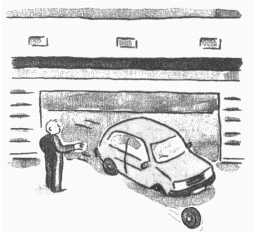Copies of this information leaflet (in English or French) can be obtained from Quality Directorate |
What do you do with problems? They are things that most people don't want to know about, apart from a few of course
who make their living by them.
So when we catch a glimpse of a problem, we have a strategy to deal with it.
Which is the correct way? Not necessarily any of these. Whose job is it to solve problems? TML handed over the infrastructure to ET last December. No one handed over a fully-working system plus a full set of satisfied and loyal customers. We are here for that. Whose job is it to solve problems? It must be ours. Not just management. Not just staff on the ground. There are problems at every level. Their number is indeterminate. There is no set date when they'll all be solved. We'd be better off learning to welcome them. |
Problems that we have already overcome are fine, a feather in our cap even (mÍme nous pouvons en Ítre fiers). They are like bearskin rugs on the floor, harmless trophies; whereas current unsolved problems are like angry, hungry bears roaming about in our garden, waiting to cause disaster. Things we'd rather not think about Problems if left unsolved may indeed cause disaster, but there's a stage short of disaster that we can learn to recognise. We may call it a loss. Losses occur when problems are not attended to. The difference between a loss and a disaster is not so great. Disasters are merely spectacular losses that cannot be ignored. There are various categories of loss.
Is there something that these losses remind you of? They bring to mind ET's objectives, in a negative way. The company wants to attract customers, keep them safe (as well as staff), keep revenue up and costs down. A loss, then, is simply something which goes against what we're in business for, what we're here for. |

